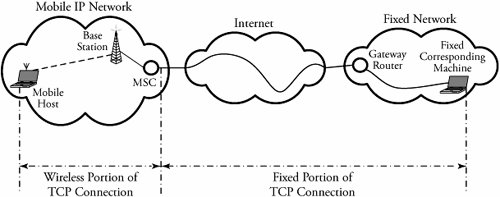Section 8.4. Mobile Transport Protocols
8.4. Mobile Transport ProtocolsIn wireless mobile networks, both UDP and TCP have their own applications. However, some modifications are needed in these protocols to become appropriate for wireless networks. One obvious reason for the modification requirement is the fact that a user (host) may move to a remote area and a seamless connection still is desirable. 8.4.1. TCP for MobilityTCP provides a reliable data delivery owing to the feature of its connection-oriented nature. The most challenging aspect of providing TCP services to a mobile host is the prevention of disruption caused by poor wireless link quality. A poor link quality typically causes to lose TCP data segments leading to a possible timeout. If the poor quality wireless channel is persistent for even a short persistent, the window remains small causing a low throughput. One option to solve this problem is to disallow a sender to shrink its congestion window when packets are lost for any reason. If a wireless channel soon recovers from disconnection, the mobile host begins to receive data immediately. There are a few other protocols for this purpose among which the Indirect Transmission Control Protocol (I-TCP), and the fast transmit will be the focus of our discussion. Indirect TCPAssume two hosts , one mobile and the other one fixed, are trying to establish an ITCP connection as shown in Figure 8.5. The I-TCP scheme first splits the connection into two separate connections. One connection is established between the mobile host and the mobile switching center (MSC) which normally attached to the wireless base station, and the other between the MSC and the fixed host. So a connection consists of two pieces: the wireless link and the fixed link. At this point, the wireless and wired link-characteristics remain hidden from the transport layer. The separation of connections into two distinct parts is advantageous to the MSC to better manage communication overheads for a mobile host. This way the throughput of connection is enhanced since the mobile host may be near the from the MSC. Figure 8.5. Indirect TCP for mobile hosts A TCP connection on the wireless portion can support disconnections, and user mobility in addition to wired TCP features such as notification to higher layers on changes in the available bandwidth. Also, the flow control and congestion control mechanisms on the wireless link remain separated from those on the wired link. In the I-TCP scheme, the TCP acknowledgments are separate for the wireless and the wired links of the connection. This resembles two different TCP connections linked together. Note that, if for any reason the mobile host disconnects the communication on the wireless portion, the sender may not become aware of the disconnection as the wired portion is still in tact, and the base station still delivers the TCP segments to the mobile host. Consequently, the sender of segments may not know of segments being delivered to the mobile host. Fast Retransmit Mobile TCPThe fast retransmit protocol is another TCP scheme for mobility. Fast Retransmit improves the connection throughput especially during a cell handoff. This scheme does not split the TCP connection to wireless and wired connections. Once two wireless cell MSCs hand off the switching function for a mobile host, the mobile host stops receiving TCP segments. This may be interpreted by the sender as a situation of congestion thereby a congestion control such as window size reduction or retransmitting may begin to be implemented. This may also result in a long timeout causing the mobile host to wait a long period of time. With the fast retransmit TCP, the last old acknowledgment is triplicated and retransmitted by the mobile host as soon as it finishes a handoff . This results in significant reduction of the congestion window. 8.4.2. UDP for MobilityUDP is used in wireless mobile IP networks for several reasons. We learned in Chapter 6 that a mobile host needs to register with a foreign agent. The registration with an agent on a foreign network is done using UDP. This process starts with a foreign agent propagating advertisements using UDP connection. Since the traditional UDP does not use acknowledgments and does not perform flow control, it is not a preferred choice of transport prtocol. One way of handling this situation is to stop sending datagrams to a mobile host once it reports fading. But this method cannot be practical due to its poor quality of connection. |
EAN: 2147483647
Pages: 211